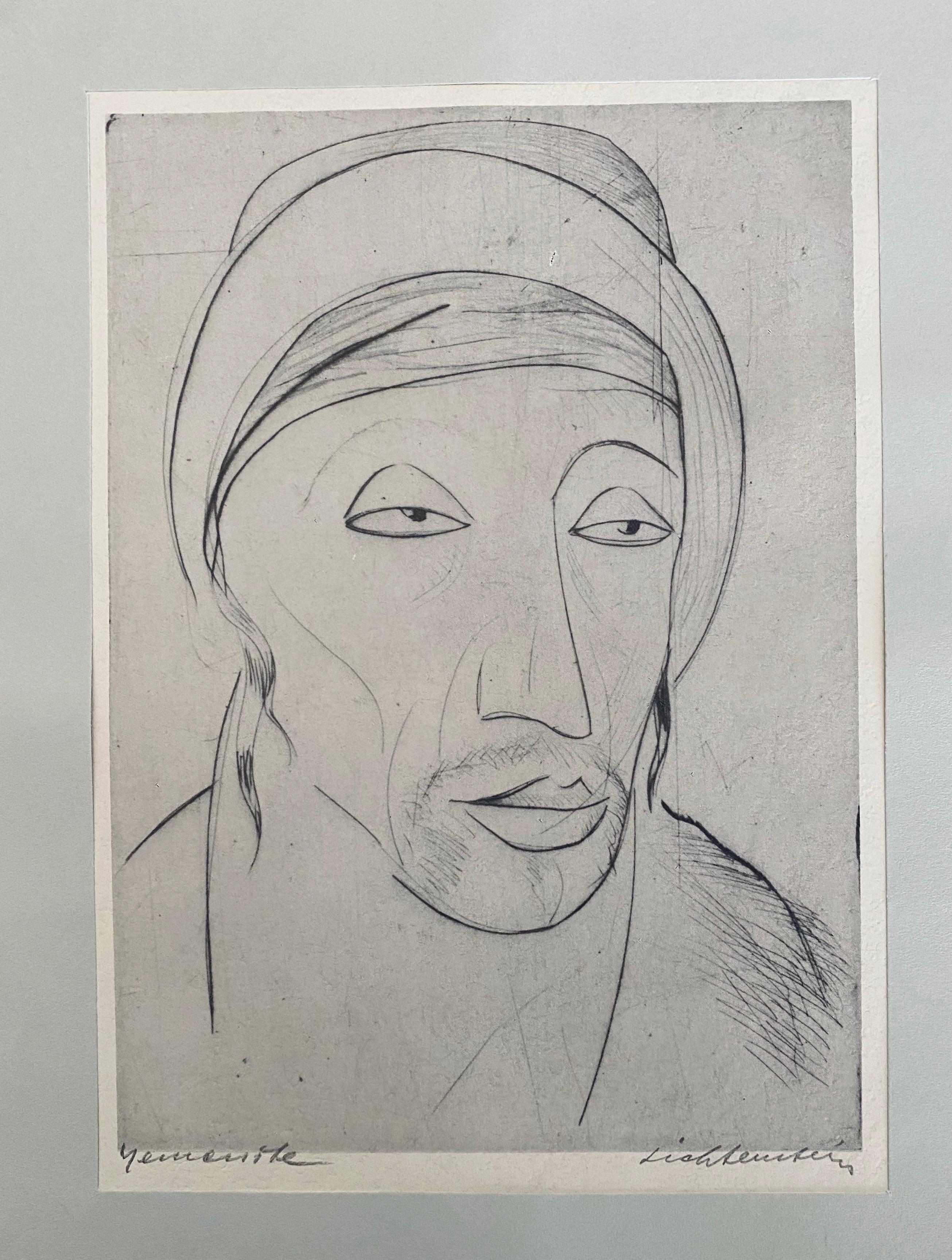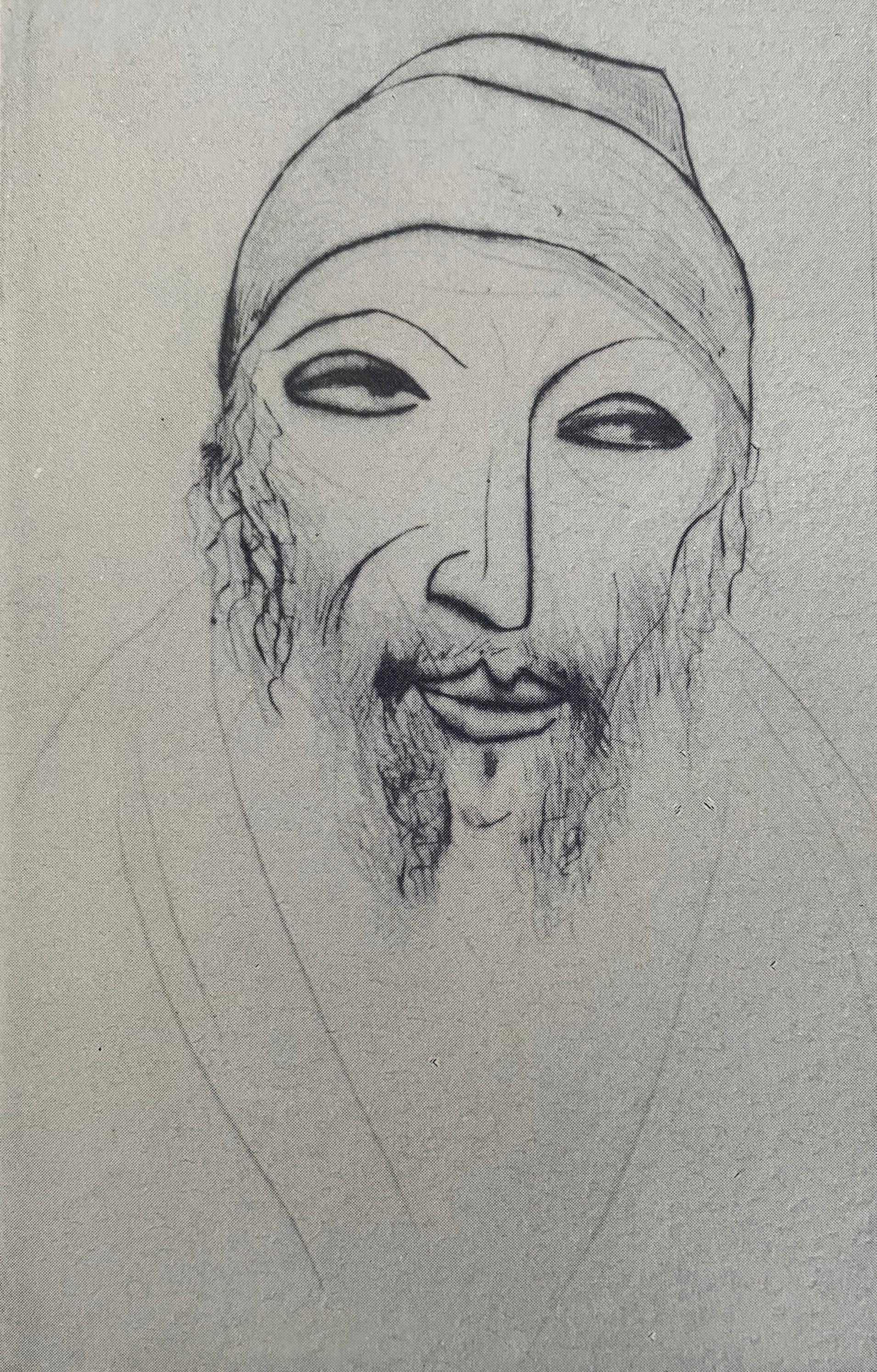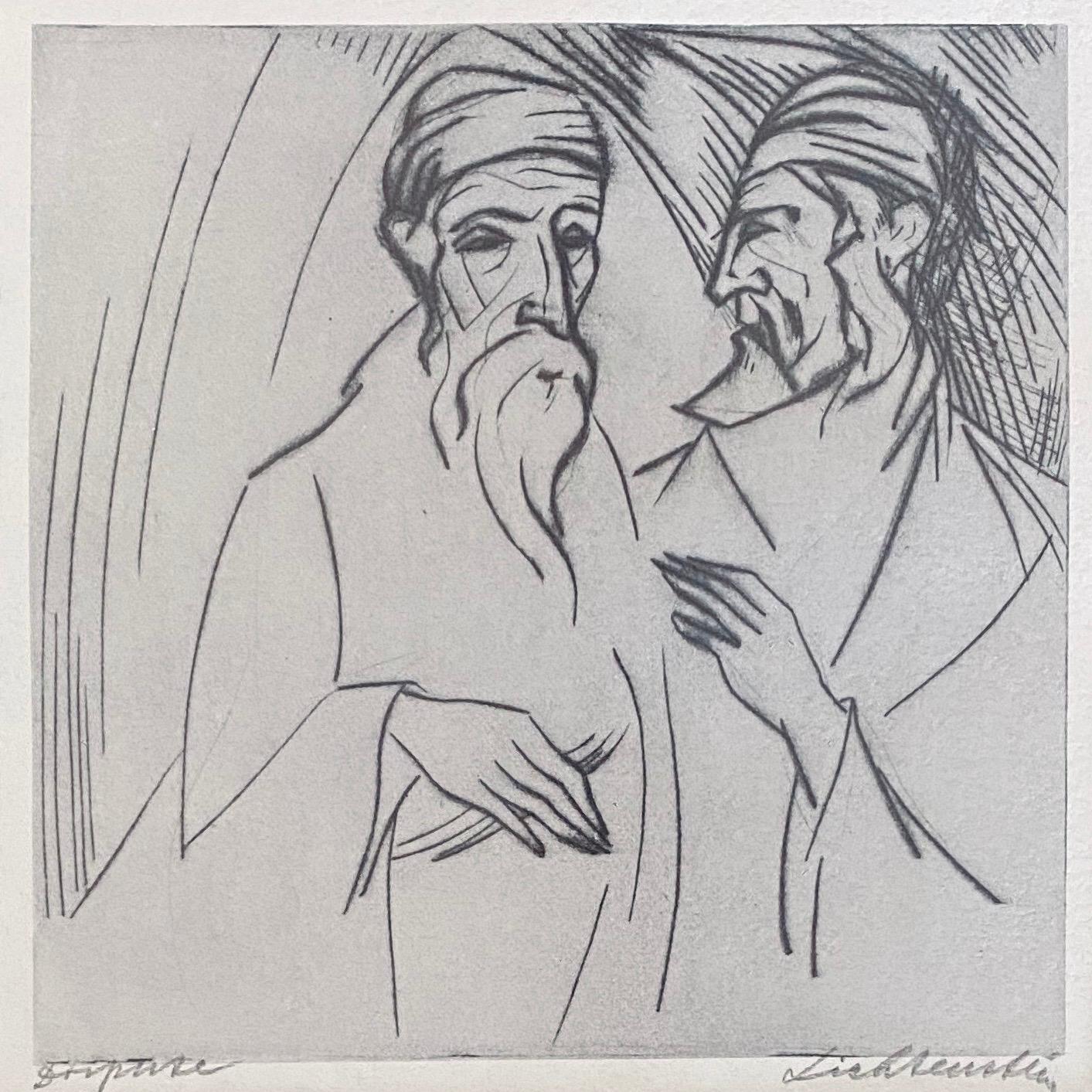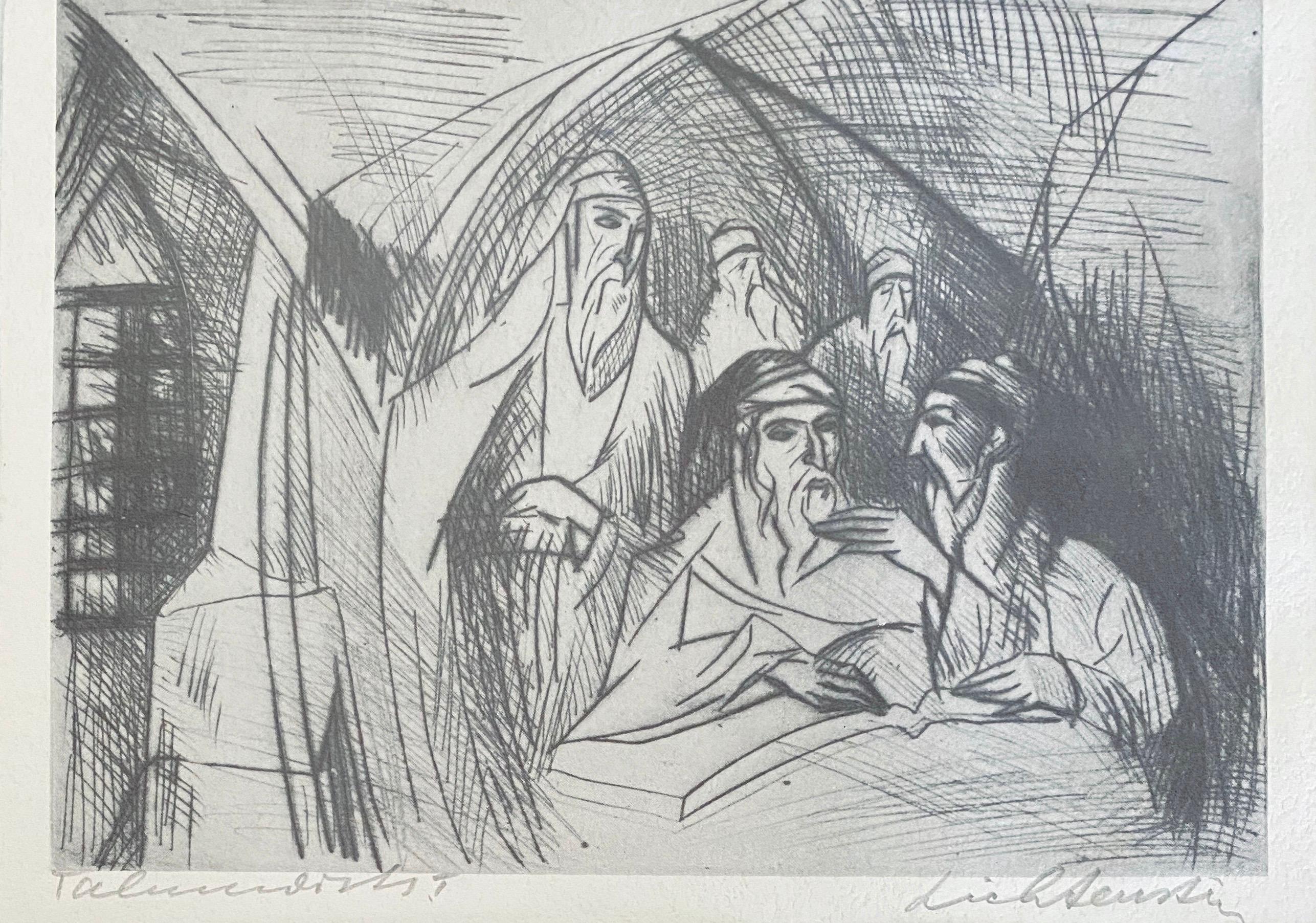Items Similar to Bezalel School Jerusalem Israeli Judaica Etching
Want more images or videos?
Request additional images or videos from the seller
1 of 12
Isaac Lichtenstein 1 Bezalel School Jerusalem Israeli Judaica Etching
About the Item
YITSKHOK LIKHTENSHTEYN (ISAAC LICHTENSTEIN) (1888-1981) (Icchok, Izrael) was born in Lodz, Poland. Initially he was studying at Yehuda Pen school in Witebsk. In the same school where young Marc Chagall started to paint his shtetl Jews, Jewish neighbourhoods and personages. As many young Jewish children who decided painting to be their passion Isaac moved to Paris where he was one of the co-founders of Machmadim - a group of Jewish artists (mostly émigré from Eastern Europe) who dedicated their art to traditional Jewish themes. Later Isaac Lichtenstein studied with Boris Schatz and painted at Bezalel, Jerusalem. Until age seven he was raised in Warsaw; later, when his father received a position with Poznański, he lived with his parents in Lodz. There he studied in a state public school. He demonstrated talent for painting while still quite young, and in 1906 he began to attend the Cracow art academy, before going on to study painting in Rome, Florence, and Munich. In 1908 he entered the Bezalel Art School in Jerusalem. In 1910 he returned to Cracow, lived for a short time in Munich, 1911 in Paris, 1912-1913 again in the land of Israel, and in 1914 he returned to Paris, that very year setting off for the United States. He lived in New York during WWI, where he became part of Jewish literary and artistic circles, and contributed as a graphic artist to a variety of Jewish publications, among them: M. Basin’s Antologye (Anthology), the collection Velt ayn, velt oys (World in, world out), and designed frontispieces, little vignettes, and letters for Yiddish-language books. In 1916 he also began to write and published articles on the plastic arts in: Tsukunft (Future) in New York; the collection Shriften (Writings), vol. 6; Onheyb (Beginning), edited by Z. Vaynper; Morgn-zhurnal (Morning journal); Der amerikaner (The American); Forverts (Forward); and Di tsayt (The times). He did journalistic work also for M. F. Seidman’s correspondence bureau in New York. In 1918 he departed with the Jewish Legion for Israel. In 1920 he came to London, was demobilized there, and was a contributor to the journal Renesans (Renaissance), edited by Leo Kenig, and to the daily newspaper Di tsayt, edited by Morris Meyer. In 1924 he returned to Poland, exhibited his drawings in Warsaw, Lodz, Vilna, and other cities, gave speeches on art (general and Jewish), and published work in: Haynt (Today), Moment (Moment), Folkstsaytung (People’s newspaper), and Literarishe bleter (Literary leaves)—in Warsaw; Unzer lebn (Our life) in Grodno; Voliner lebn (Volhynia life); Nayer folksblat (New people’s newspaper) in Lodz; and elsewhere. He also published impressions from his travels and memoirs of the Jewish Legion in Haynt. In 1927 he founded with the Parisian publisher Triangle a series entitled “Yidn-kinstler, monografyes” (Jewish artists, monographs), for which he wrote: Mark shagal (Marc Chagall) (1927), 16 pp.; and Shmuel Hirshenberg (Samuel Hirszenberg) (1928), 19 pp. Both of these monographs were translated into English and published in B’nai B’rith Magazine. In 1938 he commenced a world exhibition in New York and there he remained. In 1941 he revived in New York the art publisher Maḥmadim (founded in Paris in 1912), and it published: his art portfolio Yerushalayim (Jerusalem), 10 plates; Yankev Glatshteyn’s Yosl loksh fun khelem (Yosl Noodle from Chełm), with music by Henekh Kon and illustrations by Likhtenshetyn (1944); Geto-motivn (Ghetto motifs) by the artist Avrom Volkovitsh, with an appreciation of the artist by Likhtenshteyn (1946); the album, Kedoshim, lider far farpaynikte (Martyrs, songs for those who suffered), with Likhtenstein’s drawings and music by Henekh Kon (1947). He served as director of the art center of the World Jewish Culture Congress in New York. He arranged exhibitions of Jewish and Israeli artists, ran series of art-evenings in the auditorium of the Jewish Museum, designed covers for Yiddish books, and contributed work to: Tsukunft (Future), Idisher kemfer (Jewish fighter), Legyonern-zhurnal (Legionnaire’s journal), Unzer tsayt (Our time), the anthology Vitebsk amol (Vitebsk in the past), and Almanakh yidish (Yiddish almanac), among other publications. In 1960 he made a long trip to Europe and the state of Israel. He was last living in New York.
After WW2 he moved to New York and dedicated his life to painting and publishing illustrated Jewish books. He also helped many young Jewish artists to emerge on scene. Not many of Isaac Lichtensteins paintings survived Holocaust and wars. But there are some held at the Ben Uri collection in London.
- Creator:
- Dimensions:Height: 11 in (27.94 cm)Width: 13.13 in (33.36 cm)
- Medium:
- Movement & Style:
- Period:
- Condition:Minor toning and creasing around edges. Please see photos.
- Gallery Location:Surfside, FL
- Reference Number:1stDibs: LU3826683892
About the Seller
4.9
Platinum Seller
These expertly vetted sellers are 1stDibs' most experienced sellers and are rated highest by our customers.
Established in 1995
1stDibs seller since 2014
1,560 sales on 1stDibs
Typical response time: 1 hour
- ShippingRetrieving quote...Ships From: Surfside, FL
- Return PolicyA return for this item may be initiated within 3 days of delivery.
More From This SellerView All
- Bezalel School Jerusalem Israeli Judaica EtchingBy Isaac Lichtenstein 1Located in Surfside, FLYITSKHOK LIKHTENSHTEYN (ISAAC LICHTENSTEIN) (1888-1981) (Icchok, Izrael) was born in Lodz, Poland. Initially he was studying at Yehuda Pen school in Witebsk. In the same school where young Marc Chagall started to paint his shtetl Jews, Jewish neighbourhoods and personages. As many young Jewish children who decided painting to be their passion Isaac moved to Paris where he was one of the co-founders of Machmadim - a group of Jewish artists (mostly émigré from Eastern Europe) who dedicated their art to traditional Jewish themes. Later Isaac Lichtenstein studied with Boris Schatz and painted at Bezalel, Jerusalem. Until age seven he was raised in Warsaw; later, when his father received a position with Poznański, he lived with his parents in Lodz. There he studied in a state public school. He demonstrated talent for painting while still quite young, and in 1906 he began to attend the Cracow art academy, before going on to study painting in Rome, Florence, and Munich. In 1908 he entered the Bezalel Art School in Jerusalem. In 1910 he returned to Cracow, lived for a short time in Munich, 1911 in Paris, 1912-1913 again in the land of Israel, and in 1914 he returned to Paris, that very year setting off for the United States. He lived in New York during WWI, where he became part of Jewish literary and artistic circles, and contributed as a graphic artist to a variety of Jewish publications, among them: M. Basin’s Antologye (Anthology), the collection Velt ayn, velt oys (World in, world out), and designed frontispieces, little vignettes, and letters for Yiddish-language books. In 1916 he also began to write and published articles on the plastic arts in: Tsukunft (Future) in New York; the collection Shriften (Writings), vol. 6; Onheyb (Beginning), edited by Z. Vaynper; Morgn-zhurnal (Morning journal); Der amerikaner (The American); Forverts (Forward); and Di tsayt (The times). He did journalistic work also for M. F. Seidman’s correspondence bureau in New York. In 1918 he departed with the Jewish Legion for Israel. In 1920 he came to London, was demobilized there, and was a contributor to the journal Renesans (Renaissance), edited by Leo Kenig, and to the daily newspaper Di tsayt, edited by Morris Meyer. In 1924 he returned to Poland, exhibited his drawings in Warsaw, Lodz, Vilna, and other cities, gave speeches on art (general and Jewish), and published work in: Haynt (Today), Moment (Moment), Folkstsaytung (People’s newspaper), and Literarishe bleter (Literary leaves)—in Warsaw; Unzer lebn (Our life) in Grodno; Voliner lebn (Volhynia life); Nayer folksblat (New people’s newspaper) in Lodz; and elsewhere. He also published impressions from his travels and memoirs of the Jewish Legion in Haynt. In 1927 he founded with the Parisian publisher Triangle a series entitled “Yidn-kinstler, monografyes” (Jewish artists, monographs), for which he wrote: Mark shagal...Category
Early 20th Century Post-Impressionist Drawings and Watercolor Paintings
MaterialsEtching
- Bezalel School Jerusalem Israeli Judaica Etching - FaceBy Isaac Lichtenstein 1Located in Surfside, FLYITSKHOK LIKHTENSHTEYN (ISAAC LICHTENSTEIN) (1888-1981) (Icchok, Izrael) was born in Lodz, Poland. Initially he was studying at Yehuda Pen school in Witebsk. In the same school where young Marc Chagall started to paint his shtetl Jews, Jewish neighbourhoods and personages. As many young Jewish children who decided painting to be their passion Isaac moved to Paris where he was one of the co-founders of Machmadim - a group of Jewish artists (mostly émigré from Eastern Europe) who dedicated their art to traditional Jewish themes. Later Isaac Lichtenstein studied with Boris Schatz and painted at Bezalel, Jerusalem. Until age seven he was raised in Warsaw; later, when his father received a position with Poznański, he lived with his parents in Lodz. There he studied in a state public school. He demonstrated talent for painting while still quite young, and in 1906 he began to attend the Cracow art academy, before going on to study painting in Rome, Florence, and Munich. In 1908 he entered the Bezalel Art School in Jerusalem. In 1910 he returned to Cracow, lived for a short time in Munich, 1911 in Paris, 1912-1913 again in the land of Israel, and in 1914 he returned to Paris, that very year setting off for the United States. He lived in New York during WWI, where he became part of Jewish literary and artistic circles, and contributed as a graphic artist to a variety of Jewish publications, among them: M. Basin’s Antologye (Anthology), the collection Velt ayn, velt oys (World in, world out), and designed frontispieces, little vignettes, and letters for Yiddish-language books. In 1916 he also began to write and published articles on the plastic arts in: Tsukunft (Future) in New York; the collection Shriften (Writings), vol. 6; Onheyb (Beginning), edited by Z. Vaynper; Morgn-zhurnal (Morning journal); Der amerikaner (The American); Forverts (Forward); and Di tsayt (The times). He did journalistic work also for M. F. Seidman’s correspondence bureau in New York. In 1918 he departed with the Jewish Legion for Israel. In 1920 he came to London, was demobilized there, and was a contributor to the journal Renesans (Renaissance), edited by Leo Kenig, and to the daily newspaper Di tsayt, edited by Morris Meyer. In 1924 he returned to Poland, exhibited his drawings in Warsaw, Lodz, Vilna, and other cities, gave speeches on art (general and Jewish), and published work in: Haynt (Today), Moment (Moment), Folkstsaytung (People’s newspaper), and Literarishe bleter (Literary leaves)—in Warsaw; Unzer lebn (Our life) in Grodno; Voliner lebn (Volhynia life); Nayer folksblat (New people’s newspaper) in Lodz; and elsewhere. He also published impressions from his travels and memoirs of the Jewish Legion in Haynt. In 1927 he founded with the Parisian publisher Triangle a series entitled “Yidn-kinstler, monografyes” (Jewish artists, monographs), for which he wrote: Mark shagal...Category
Early 20th Century Post-Impressionist Drawings and Watercolor Paintings
MaterialsEtching
- Bezalel School Jerusalem Israeli Judaica EtchingBy Isaac Lichtenstein 1Located in Surfside, FLYITSKHOK LIKHTENSHTEYN (ISAAC LICHTENSTEIN) (1888-1981) (Icchok, Izrael) was born in Lodz, Poland. Initially he was studying at Yehuda Pen school in Witebsk. In the same school where young Marc Chagall started to paint his shtetl Jews, Jewish neighbourhoods and personages. As many young Jewish children who decided painting to be their passion Isaac moved to Paris where he was one of the co-founders of Machmadim - a group of Jewish artists (mostly émigré from Eastern Europe) who dedicated their art to traditional Jewish themes. Later Isaac Lichtenstein studied with Boris Schatz and painted at Bezalel, Jerusalem. Until age seven he was raised in Warsaw; later, when his father received a position with Poznański, he lived with his parents in Lodz. There he studied in a state public school. He demonstrated talent for painting while still quite young, and in 1906 he began to attend the Cracow art academy, before going on to study painting in Rome, Florence, and Munich. In 1908 he entered the Bezalel Art School in Jerusalem. In 1910 he returned to Cracow, lived for a short time in Munich, 1911 in Paris, 1912-1913 again in the land of Israel, and in 1914 he returned to Paris, that very year setting off for the United States. He lived in New York during WWI, where he became part of Jewish literary and artistic circles, and contributed as a graphic artist to a variety of Jewish publications, among them: M. Basin’s Antologye (Anthology), the collection Velt ayn, velt oys (World in, world out), and designed frontispieces, little vignettes, and letters for Yiddish-language books. In 1916 he also began to write and published articles on the plastic arts in: Tsukunft (Future) in New York; the collection Shriften (Writings), vol. 6; Onheyb (Beginning), edited by Z. Vaynper; Morgn-zhurnal (Morning journal); Der amerikaner (The American); Forverts (Forward); and Di tsayt (The times). He did journalistic work also for M. F. Seidman’s correspondence bureau in New York. In 1918 he departed with the Jewish Legion for Israel. In 1920 he came to London, was demobilized there, and was a contributor to the journal Renesans (Renaissance), edited by Leo Kenig, and to the daily newspaper Di tsayt, edited by Morris Meyer. In 1924 he returned to Poland, exhibited his drawings in Warsaw, Lodz, Vilna, and other cities, gave speeches on art (general and Jewish), and published work in: Haynt (Today), Moment (Moment), Folkstsaytung (People’s newspaper), and Literarishe bleter (Literary leaves)—in Warsaw; Unzer lebn (Our life) in Grodno; Voliner lebn (Volhynia life); Nayer folksblat (New people’s newspaper) in Lodz; and elsewhere. He also published impressions from his travels and memoirs of the Jewish Legion in Haynt. In 1927 he founded with the Parisian publisher Triangle a series entitled “Yidn-kinstler, monografyes” (Jewish artists, monographs), for which he wrote: Mark shagal...Category
Early 20th Century Post-Impressionist Drawings and Watercolor Paintings
MaterialsEtching
- Bezalel School Jerusalem Israeli Judaica Etching - BeggarsBy Isaac Lichtenstein 1Located in Surfside, FLYITSKHOK LIKHTENSHTEYN (ISAAC LICHTENSTEIN) (1888-1981) (Icchok, Izrael) was born in Lodz, Poland. Initially he was studying at Yehuda Pen school in Witebsk. In the same school where young Marc Chagall started to paint his shtetl Jews, Jewish neighbourhoods and personages. As many young Jewish children who decided painting to be their passion Isaac moved to Paris where he was one of the co-founders of Machmadim - a group of Jewish artists (mostly émigré from Eastern Europe) who dedicated their art to traditional Jewish themes. Later Isaac Lichtenstein studied with Boris Schatz and painted at Bezalel, Jerusalem. Until age seven he was raised in Warsaw; later, when his father received a position with Poznański, he lived with his parents in Lodz. There he studied in a state public school. He demonstrated talent for painting while still quite young, and in 1906 he began to attend the Cracow art academy, before going on to study painting in Rome, Florence, and Munich. In 1908 he entered the Bezalel Art School in Jerusalem. In 1910 he returned to Cracow, lived for a short time in Munich, 1911 in Paris, 1912-1913 again in the land of Israel, and in 1914 he returned to Paris, that very year setting off for the United States. He lived in New York during WWI, where he became part of Jewish literary and artistic circles, and contributed as a graphic artist to a variety of Jewish publications, among them: M. Basin’s Antologye (Anthology), the collection Velt ayn, velt oys (World in, world out), and designed frontispieces, little vignettes, and letters for Yiddish-language books. In 1916 he also began to write and published articles on the plastic arts in: Tsukunft (Future) in New York; the collection Shriften (Writings), vol. 6; Onheyb (Beginning), edited by Z. Vaynper; Morgn-zhurnal (Morning journal); Der amerikaner (The American); Forverts (Forward); and Di tsayt (The times). He did journalistic work also for M. F. Seidman’s correspondence bureau in New York. In 1918 he departed with the Jewish Legion for Israel. In 1920 he came to London, was demobilized there, and was a contributor to the journal Renesans (Renaissance), edited by Leo Kenig, and to the daily newspaper Di tsayt, edited by Morris Meyer. In 1924 he returned to Poland, exhibited his drawings in Warsaw, Lodz, Vilna, and other cities, gave speeches on art (general and Jewish), and published work in: Haynt (Today), Moment (Moment), Folkstsaytung (People’s newspaper), and Literarishe bleter (Literary leaves)—in Warsaw; Unzer lebn (Our life) in Grodno; Voliner lebn (Volhynia life); Nayer folksblat (New people’s newspaper) in Lodz; and elsewhere. He also published impressions from his travels and memoirs of the Jewish Legion in Haynt. In 1927 he founded with the Parisian publisher Triangle a series entitled “Yidn-kinstler, monografyes” (Jewish artists, monographs), for which he wrote: Mark shagal...Category
Early 20th Century Post-Impressionist Drawings and Watercolor Paintings
MaterialsEtching
- Bezalel School Jerusalem Israeli Judaica EtchingBy Isaac Lichtenstein 1Located in Surfside, FLYITSKHOK LIKHTENSHTEYN (ISAAC LICHTENSTEIN) (1888-1981) (Icchok, Izrael) was born in Lodz, Poland. Initially he was studying at Yehuda Pen school in Witebsk. In the same school where young Marc Chagall started to paint his shtetl Jews, Jewish neighbourhoods and personages. As many young Jewish children who decided painting to be their passion Isaac moved to Paris where he was one of the co-founders of Machmadim - a group of Jewish artists (mostly émigré from Eastern Europe) who dedicated their art to traditional Jewish themes. Later Isaac Lichtenstein studied with Boris Schatz and painted at Bezalel, Jerusalem. Until age seven he was raised in Warsaw; later, when his father received a position with Poznański, he lived with his parents in Lodz. There he studied in a state public school. He demonstrated talent for painting while still quite young, and in 1906 he began to attend the Cracow art academy, before going on to study painting in Rome, Florence, and Munich. In 1908 he entered the Bezalel Art School in Jerusalem. In 1910 he returned to Cracow, lived for a short time in Munich, 1911 in Paris, 1912-1913 again in the land of Israel, and in 1914 he returned to Paris, that very year setting off for the United States. He lived in New York during WWI, where he became part of Jewish literary and artistic circles, and contributed as a graphic artist to a variety of Jewish publications, among them: M. Basin’s Antologye (Anthology), the collection Velt ayn, velt oys (World in, world out), and designed frontispieces, little vignettes, and letters for Yiddish-language books. In 1916 he also began to write and published articles on the plastic arts in: Tsukunft (Future) in New York; the collection Shriften (Writings), vol. 6; Onheyb (Beginning), edited by Z. Vaynper; Morgn-zhurnal (Morning journal); Der amerikaner (The American); Forverts (Forward); and Di tsayt (The times). He did journalistic work also for M. F. Seidman’s correspondence bureau in New York. In 1918 he departed with the Jewish Legion for Israel. In 1920 he came to London, was demobilized there, and was a contributor to the journal Renesans (Renaissance), edited by Leo Kenig, and to the daily newspaper Di tsayt, edited by Morris Meyer. In 1924 he returned to Poland, exhibited his drawings in Warsaw, Lodz, Vilna, and other cities, gave speeches on art (general and Jewish), and published work in: Haynt (Today), Moment (Moment), Folkstsaytung (People’s newspaper), and Literarishe bleter (Literary leaves)—in Warsaw; Unzer lebn (Our life) in Grodno; Voliner lebn (Volhynia life); Nayer folksblat (New people’s newspaper) in Lodz; and elsewhere. He also published impressions from his travels and memoirs of the Jewish Legion in Haynt. In 1927 he founded with the Parisian publisher Triangle a series entitled “Yidn-kinstler, monografyes” (Jewish artists, monographs), for which he wrote: Mark shagal...Category
Early 20th Century Post-Impressionist Drawings and Watercolor Paintings
MaterialsEtching
- Bezalel School Jerusalem Israeli Judaica EtchingBy Isaac Lichtenstein 1Located in Surfside, FLYITSKHOK LIKHTENSHTEYN (ISAAC LICHTENSTEIN) (1888-1981) (Icchok, Izrael) was born in Lodz, Poland. Initially he was studying at Yehuda Pen school in Witebsk. In the same school wh...Category
Early 20th Century Post-Impressionist Drawings and Watercolor Paintings
MaterialsEtching
You May Also Like
- untitled, still life fish, wineLocated in Belgrade, MTThis etching is from my private collection of 20th Century artists. It is original, signed and numbered. Edouard Righetti (1921-2001) was a French post impressionist artist who speci...Category
Mid-20th Century Post-Impressionist Still-life Prints
MaterialsPaint, ABS, Etching, Lithograph
- Our Husbands - Ink and Watercolor by L. Bompard - Early 1900By Luigi BompardLocated in Roma, ITOriginal Drawing, watercolor. Signed by the artist. Handwritten Notes in lower. Watercolor and china ink drawing. Fair conditions, lightly damaged. This artwork is shipped from Ital...Category
Early 20th Century Post-Impressionist Figurative Drawings and Watercolors
MaterialsPaper
- City View - Watercolor by French Master - Mid 20th CenturyLocated in Roma, ITCity View is an original Watercolour on paper realized by an artist of the XX century. The state of preservation of the artwork is very good hand-signed on the bottom left. the sign ...Category
Mid-20th Century Post-Impressionist Figurative Drawings and Watercolors
MaterialsWatercolor
- Les Parasols Blancs - Montmartre by H. Claude Pissarro - Pastel on CardBy Hughes Claude PissarroLocated in London, GB*UK BUYERS WILL PAY AN ADDITIONAL 20% VAT ON TOP OF THE ABOVE PRICE Les Parasols Blancs - Montmartre by H. Claude Pissarro (b. 1935) Pastel on card 51 x 37 cm (20 ⅛ x 14 ⅝ inches) S...Category
21st Century and Contemporary Post-Impressionist Figurative Drawings and...
MaterialsPastel
- Dimanche à Robinson by H. Claude Pissarro - Pastel, Post-ImpressionistBy Hughes Claude PissarroLocated in London, GB*UK BUYERS WILL PAY AN ADDITIONAL 20% VAT ON TOP OF THE ABOVE PRICE Dimanche à Robinson by H. Claude Pissarro (b. 1935) Pastel on card 37 x 51 cm (14 ⁵/₈ x 20 ¹/₈ inches) Signed low...Category
21st Century and Contemporary Post-Impressionist Figurative Drawings and...
MaterialsPastel
- Les Équipages de l'Allée Acacias by H. Claude Pissarro - PastelLocated in London, GB*UK BUYERS WILL PAY AN ADDITIONAL 20% VAT ON TOP OF THE ABOVE PRICE Les Équipages de l'Allée Acacias by H. Claude Pissarro (b. 1935) Pastel on card 37 x 51 cm (14 ⁵/₈ x 20 ¹/₈ inche...Category
21st Century and Contemporary Post-Impressionist Figurative Drawings and...
MaterialsPastel





